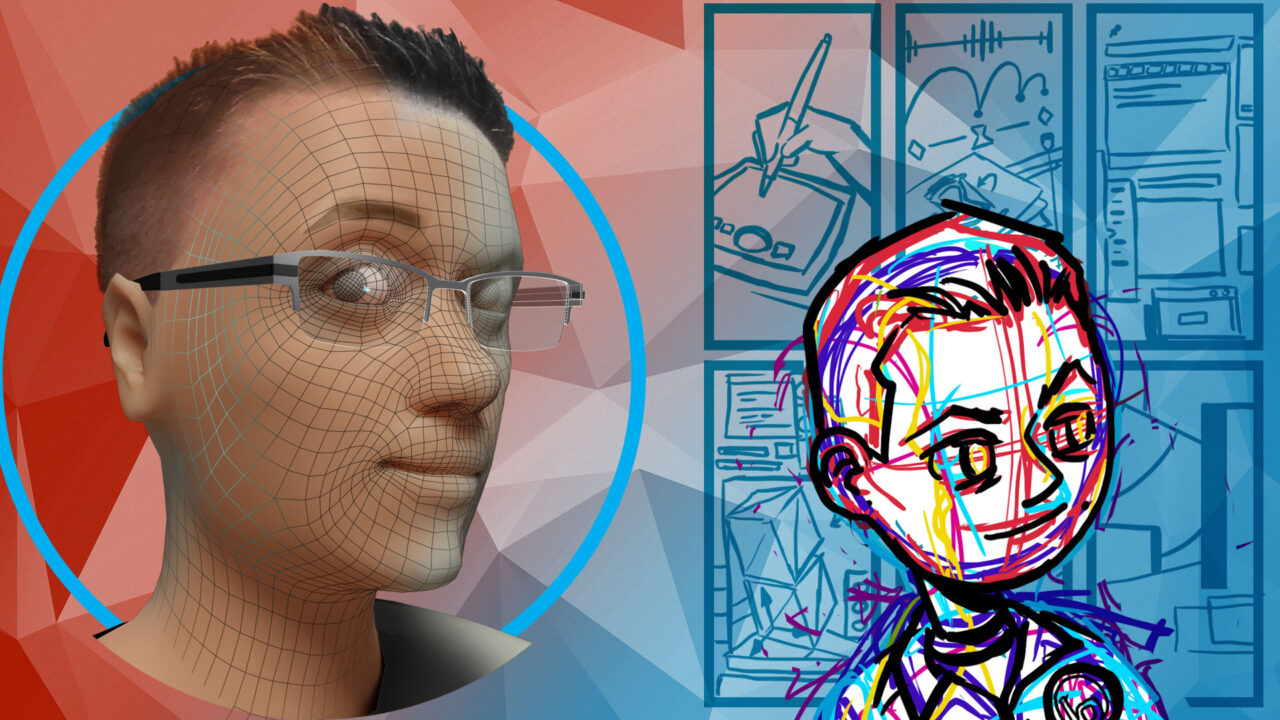One might think it’s hard to be original when a twin. It’s not. Take for example Paul or Philip Keefer, our profiled twins of talent.
IT’S A SCIENTIST, IT’S AN ARTIST, IT’S PAUL KEEFER!
If you’re talking animation with Paul Keefer, you’d better bring your A game. He’s scientific; he’s also artistic. His animations are elegant, but when he tries to describe how he created them, it sounds something like this:
“It’s kind of like paralleling a film studio, like a photo studio, only completely fabricated. The model being recorded is made of polygons, textured with a fake surface, with fake lights imitating real photons over time.”

Or “computer graphics” for short.
Not surprisingly, Paul considered a career in the sciences. “For a while, I thought I’d pursue some kind of chromosomal or genetic research,” he said. He also considered becoming an author. Or a painter.
He said being an animator at Bartha offers a little of all of that. Case in point: a video for the OSU Neurological Institute.
Paul received a script including the direction, “Fade up on human brain. Zoom animation slowly moves in to close-up on brain, interior, and structure, with neurons represented.”
The scientific side of Paul’s brain lit up. “I had to study brain cells, the different types, even the placement of the glial cells.”
He set up a studio, animating a camera through a model of a human brain. Multiple lighting treatments allowed him to layer dozens of images, creating a 3D image that resembled a brain floating in fog. With a compositing program, Paul masked on additional effects, giving the appearance of neurons firing as the viewer “flew” through the brain. “There are pure middle neurons and outer layers of cortex, kind of tree-like structures with lot of branching axons,” he explained. “So I randomly selected those masked alphas and used the opacity to light them up at different rates.”
Whether it’s a brain or a logo, animators like Paul bring objects to life by studying how they naturally move, disassembling the image, and animating the whole thing with motion design.
“More clients are asking for more dynamic animation. With motion graphics, you have to study movement, and cooperate with the solvers, using math to simulate particles.”
Uh, okay.
Paul laughs. “It’s all pretty straightforward to me.”
Imagine what he can do with a title slide.

FROM BLOB CREATURES TO DANCING LOGOS; IT’S AN ART THING. IT’S PHILIP KEEFER!

“As far back as I can remember I’ve been drawing things,” said animator Philip Keefer. “I still have old crayon scribbles of ninja turtles, and all these hideous blob creatures I did.”
Philip’s love of drawing lead him from those “hideous blob creatures” to the amazing animations he creates for various Bartha events and projects today.
When it came time for Philip to choose a college major, he considered history, literature, and science in addition to art. A scholarship offer from the Columbus College of Art & Design (CCAD) sealed the deal and he and his twin brother Paul, also a Bartha animator, packed their bags.
In the early 2000s many schools, including CCAD, were just entering the world of animation education. “Actually, when I got my degree in 2006, it was called Time-Based Media Studies.” (Photography, on the other hand, was referred to as Still-Based Media Studies. Get it?)
Philip chose animation for the variety and scope of projects he’d be able to take on. “Animation seemed broader to me than illustration or fine arts. Everything from traditional 2D to 3D animation, experimental, motion graphics, video and film to compositing and effects – all of that falls under the animation umbrella.”
The opportunity to work with Bartha’s rapidly growing video department was attractive to Philip, especially as he wanted to refocus on animation and not the web design work he’d done in his previous position. He joined the Bartha team two years ago this month.
“What I really like about what I have here is that there’s always something new.”
“One week I’m animating a show logo dancing on stage, then I’m creating a giant particle explosion, or inspirational words flying around for an MLK tribute. Every week there’s a different challenge. I like that.”
Additional challenges that Philip enjoys tackling include storyboarding videos, creating animation, compositing, motion graphics and working with other Bartha artists on set renderings and sketches for proposals. He wanted variety and scope and he got it!
We’re all glad Philip chose to pursue art over history, literature, or science. And so are our clients.



